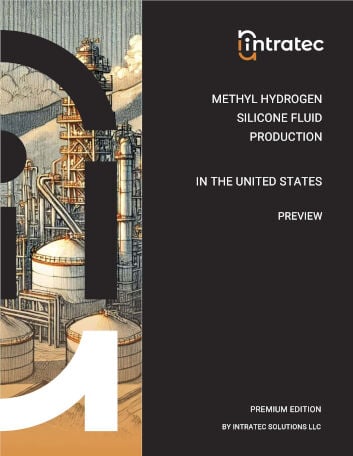Commodity Production Costs Report
Low Viscosity Silicone Fluid Production
Silicone Plant Capital & Operating Cost Analysis | United States | Q3 2025
This report presents the economics of Low Viscosity Silicone Fluid production, more specifically Polydimethylsiloxanes (PDMS). The plant examined involves the production of linear siloxanes intermediate from dimethylchlorosilane and the subsequent production of Low Viscosity Silicone Fluid. In this process, a mixture of cyclic and linear siloxanes is produced by hydrolysis of dimethylchlorosilane. Linear siloxanes are separated and then polymerized using hexamethyldisiloxane as a chain broker for molecular weight control. Hydrogen chloride is also obtained from the hydrolysis. The acid and the cyclic siloxanes are sold as by-products.
The report provides a comprehensive study of Silicone production and related Silicone production cost, covering three key aspects: a complete description of the Silicone production process examined; an in-depth analysis of the related Silicone plant capital cost (Capex); and an evaluation of the respective Silicone plant operating costs (Opex).
The Silicone production process description includes a block flow diagram (BFD), an overview of the industrial site installations, detailing both the process unit and the necessary infrastructure, process consumption figures and comprehensive process flow diagrams (PFD). The Silicone plant capital cost analysis breaks down the Capex by plant cost (i.e., ISBL, OSBL and Contingency); owner's cost; working capital; and costs incurred during industrial plant commissioning and start-up. The Silicone plant operating costs analysis covers operating expenses, including variable costs like raw materials and utilities, and fixed costs such as maintenance, labor, and depreciation.

Product
Silicone. Silicone is a class of polymers, in which silicon atoms are linked via oxygen atoms, each silicon atom bearing one or several organic groups (usually methyl or phenyl in industrial production). Silicon compounds are quite abundant in nature, but silicones are not found naturally. They were first synthetized in 1930, with industrial production beginning nine years later and growing rapidly in the years that followed, a result of the high demand for silicones in World War II. Currently, they have a wide variety of commercial forms and applications, ranging from automotive to pharmaceutical industries.
Raw Material
Dimethyldichlorosilane. Dimethyldichlorosilane is an organosilicon compound used as a starting material for silicone polymers and resins. It reacts with water to form silanols, leading to silicone production. Manufactured from methyl chloride and silicon, it is stored as a colorless liquid. Its role in creating silicones is fundamental for applications in sealants, adhesives, and medical devices.
Report in PDF Format
Download & Explore Anytime
Access in Various Devices
Print & Read Comfortably
Share With Co-workers
Up-to-date Report
Professional report based on Q3 2025 economic data, ensuring timely evaluations.
Multiple Use Cases
Ideal for investment screening, feasibility studies, cost estimates, and research planning.
Proven Methodology
Developed using a consistent methodology honed over a decade, ensuring reliable cost analyses.
Report Editions
Content Highlights
Plant Capital Cost Summary
Summary outlining the capital cost required for building the Silicone production plant examined.
Plant Capital Cost Details
Detailing of fixed capital (ISBL, OSBL & Owner’s Cost), working capital and additional capital requirements.
Plant Cost Breakdowns
Breakdown of Silicone process unit (ISBL) costs and infrastructure (OSBL) costs; plant cost breakdown per discipline.
Operating Costs Summary
Summary presenting the operating variable costs and the total operating cost of the Silicone production plant studied.
Operating Cost Details
Detailing of utilities costs, operating fixed costs and depreciation.
Plant Capacity Assessment
Comparative analysis of capital investment and operating costs for different Silicone plant capacities.
Production Process Information
Block Flow Diagram, descriptions of process unit (ISBL) and site infrastructure (OSBL).
Process Consumptions
Raw materials and utilities consumption figures, by-products credits, labor requirements
Process Diagrams
Process flow diagrams (PFD), equipment list and industrial site configuration
Other Silicone Production Cost Reports

Silicone Surfactant Production
This report presents the economics of a process for Silicone-Polyethylene Glycol production in the United States. This silicone formulate - obtained from cyclic siloxanes (mainly octamethylcyclotetrasiloxanes), Si-H fluid (methyl hydrogen polysiloxane - MD'12M), hexamethyldisiloxane (used as chain broker for molecular weight control) and allyl PEG - is commonly used as surfactant in polyurethane foam.
Details: 8 kta United States-based plant | Q3 2025 | 107 pages | Issue A | From $799 USD

Silicone Elastomers Production
This report presents the economics of a process for Silicone Elastomers production in the United States. This Silicone Elastomer formulation is based on copolymerization of cyclic siloxanes (mainly octamethylcyclotetrasiloxanes) with vinylmethylsiloxane and phenylmethylsiloxane by vulcanization, using hexamethyldisiloxane for molecular weight control.
Details: 6 kta United States-based plant | Q3 2025 | 107 pages | Issue C | From $1,999 USD

Methyl Hydrogen Silicone Fluid Production
This report presents the economics of Methyl Hydrogen Silicone Fluid Production (a.ka. SiH Silicone) in the United States. The assessment concerns a plant producing Polymethylhydrosiloxane from methyldichlorosilane and trimethylchlorosilane hydrolysis. The plant also produces hydrogen chloride as by-product.
Details: 30 kta United States-based plant | Q3 2025 | 107 pages | Issue E | From $1,199 USD
Bundle & Save
Purchase multiple Silicone Production Cost reports and enjoy tiered discounts
up to 30% off!
Could Not Find the Report You Need?
Obtain a Bespoke Report
Get a report targeting the process in which you are interested
See Offer Details
Understand Bespoke Reports and how you can easily order them
Check Editions & Pricing
Complete a brief form and see a quotation for your Bespoke Report
Other Related Production Cost Reports

Octamethylcyclotetrasiloxane Production
This report presents the economics of Octamethylcyclotetrasiloxane production via dimethyldichlorosilanes hydrolysis. The study assumes a conventional plant located in the United States receiving a feed of dimethyldichlorosilanes. Cyclization is performed by heating the hydrolysis mixture with potassium hydroxide.
Details: 140 kta United States-based plant | Q3 2025 | 107 pages | Issue A | From $1,999 USD
+800 Reports Developed, Targeting +250 Commodities
Vast Report Library
858 independent and up-to-date reports examining embryonic and established production processes.
Free Sample Reports
Quickly understand the structure and depth of content of our professional reports.

